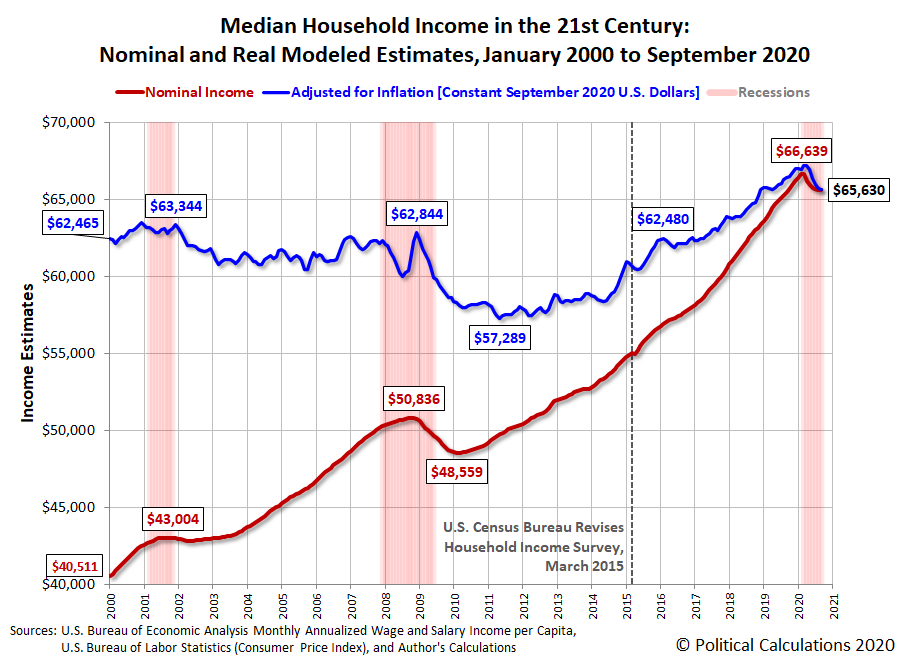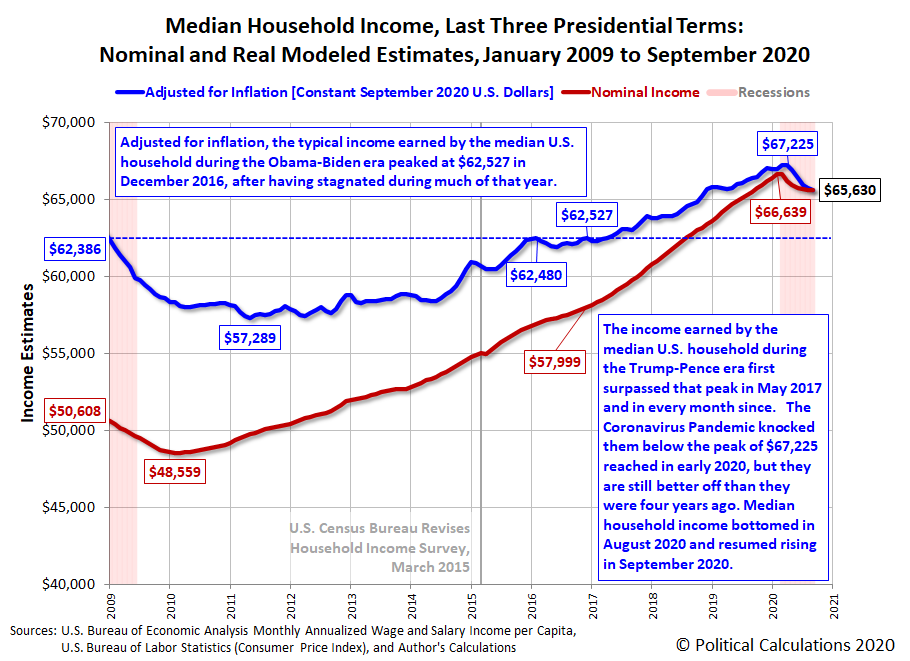Political Calculations' initial estimate of median household income of in September 2020 is $65,630, rising above the initial estimate of $65,602 recorded for August 2020. This change marks the first positive month-over-month growth in median household income since the start of the Coronavirus Recession, with August 2020 marking its bottom, as expected.
The following chart shows the nominal (red) and inflation-adjusted (blue) trends for median household income in the United States from January 2000 through September 2020. The inflation-adjusted figures are presented in terms of constant September 2020 U.S. dollars.
September 2020's estimate of median household income is 1.5% below February 2020's peak of $66,639.
The next chart zooms in on the period of the last three presidential terms to update the answer to the question "Is the typical American household better off than four years ago?"
The main differences between this chart and the previous version we introduced within the last two weeks are the inflation-adjusted figures representing the purchasing power of the median household income from January 2009 through September 2020, which are now expressed in terms of constant September 2020 U.S. dollars. We've also updated the commentary to reflect the resumption of growth in median household income in September 2020.
Analyst's Notes
In the 30 October 2020 data release, minor revisions were made to the aggregate personal wage and salary income data we use to generate our estimates of median household income, which affects the estimates for July 2020 through August 2020.
The U.S. Census Bureau issued its Household Income report for 2019 in September 2020, giving $68,703 as its estimate of median household income for the 2019 calendar year. At first glance, that figure would suggest our monthly median household estimates are understating the growth of median household income by a considerable margin, however the Census confirms the arrival of the coronavirus pandemic in the U.S. impacted its data collection in March 2020, increasing the non-response rate to its Current Population Survey's Annual Social and Economic Supplement and skewing its reported results upward because of the disruption of the pandemic.
The Census Bureau's analysts indicate the survey's resulting estimate overstates median household income by 2.8%, also indicating they believe that if they had been able to collect a more complete sample, the figure would have only increased to $66,790. That figure is within $151 of Political Calculations' median household income estimate for February 2020 and represents one of the stronger year-over-year gains observed in the annual data since it began to be reported in 1967.
Other Analyst's Notes
Sentier Research suspended reporting its monthly Current Population Survey-based estimates of median household income, concluding their series with data for December 2019. Sentier Research ceased operating in 2020, as its principals would appear to have permanently retired after a 19 year run. In their absence, we are providing the estimates from our alternate methodology for estimating median household income on a monthly basis. Our data sources are presented in the following section.
References
Sentier Research. Household Income Trends: January 2000 through December 2019. [Excel Spreadsheet with Nominal Median Household Incomes for January 2000 through January 2013 courtesy of Doug Short]. [PDF Document]. Accessed 6 February 2020. [Note: We've converted all data to be in terms of current (nominal) U.S. dollars.]
U.S. Department of Labor Bureau of Labor Statistics. Consumer Price Index, All Urban Consumers - (CPI-U), U.S. City Average, All Items, 1982-84=100. [Online Database (via Federal Reserve Economic Data)]. Last Updated: 10 September 2020. Accessed: 13 October 2020.
U.S. Bureau of Economic Analysis. Table 2.6. Personal Income and Its Disposition, Monthly, Personal Income and Outlays, Not Seasonally Adjusted, Monthly, Middle of Month. Population. [Online Database (via Federal Reserve Economic Data)]. Last Updated: 30 October 2020. Accessed: 30 October 2020.
U.S. Bureau of Economic Analysis. Table 2.6. Personal Income and Its Disposition, Monthly, Personal Income and Outlays, Not Seasonally Adjusted, Monthly, Middle of Month. Compensation of Employees, Received: Wage and Salary Disbursements. [Online Database (via Federal Reserve Economic Data)]. Last Updated: 30 October 2020. Accessed: 30 October 2020.
Labels: median household income
Welcome to the blogosphere's toolchest! Here, unlike other blogs dedicated to analyzing current events, we create easy-to-use, simple tools to do the math related to them so you can get in on the action too! If you would like to learn more about these tools, or if you would like to contribute ideas to develop for this blog, please e-mail us at:
ironman at politicalcalculations
Thanks in advance!
Closing values for previous trading day.
This site is primarily powered by:
CSS Validation
RSS Site Feed
JavaScript
The tools on this site are built using JavaScript. If you would like to learn more, one of the best free resources on the web is available at W3Schools.com.

